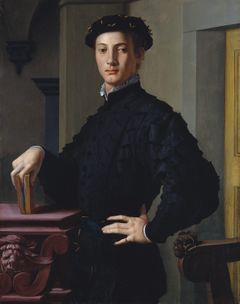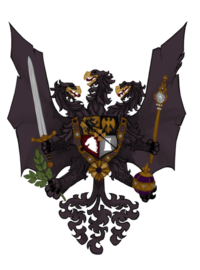William of Aanen
|
| |||||||||||||||
William Jrent, known colloquially as the Bastard Dragon (18 Godfrey's Triumph 1700 – ) was the inaugural Lord Justiciar of the Empire of Renatus. Born in the city of Touron in the Aeldinic province of Agathor, he was tutored from a young age by his father and his father's household in calligraphy, poetry, legalism, architecture, and strategy.
During the course of the War of Two Emperors, he would become infamous for his duels in penmanship with the Orenian pretender Joseph I, for being one of two chief architects of the massive superstructure known as Fort Loches and of Helena's siege defenses in the Siege of Helena, and for joining the privy council for his merit at the age of 18.
He was known to be close friends with Adeline of Alstion and Robert d'Anpalais, many attributing it to his otherwise implausibly fast rise through the ranks of Renatus.
Contents
Birth and Childhood
Born to Charles, Prince of Alstion and the Lady Livia Vladov out of wedlock when the two nobles had a summer fling in the Agathorian city of Touron and raised in his father's court, William was known from youth to be not only capable, but nearly prodigious in various arts. Comparisons were frequently drawn to his father, who not only personally taught William throughout his childhood, but was said to have been his mentor and guide through letters even upon leaving Aeldin.
War of Two Emperors
Upon the outbreak of the War of Two Emperors, he was sent at the age of 14 to the Renatian capital of Helena in order to aid the war effort in the name of his ailing father. Immediately enlisted into the Imperial Legion and soon squired to the Grand Marshal of Renatus, Ser Rozmeo Kastrovat, he boarded with his close friend and distant cousin, Robert d'Anpalais, in the outskirts of the city, and was appointed a Draughtsman of the nation in preparation for the Orenian invasion.
Initial Stages
His first action in Renatus was to plan with Robert the defenses for the most likely invasion route of the Orenian forces, through the central highway in Norland. On a grassy hill overlooking Helena, they drew up the plans and oversaw the construction of Fort Loches, the single largest structure in Arcas on the day of its completion. The fort was half-destroyed in a single night known as the Storm of Sighs, in which a massive thunderstorm collapsed the upper sections of the immense building, but was nearly rebuilt within a month.
As the construction was underway, he traded words in a duel of law and cultural understanding with the Orenian ruler, and was understood to have written the last retort between the two, Joseph I not responding a third time either through insufficient ability or time.
He participated as a Man-at-arms in the battles of Lower Rodenburg and Helena Fields, winning accolades for winning duels against fully grown adults.
Siege of Helena
Main Article: Siege of Helena
While the only road capable of transporting such a large army as Oren's was then sufficiently defended, however, Orenian marshals rerouted an army twenty-thousand strong through a dense forest. William was then immediately recalled to plan the defensive work of the palace. There, he built the Gates of the Dragon, said to be impenetrable by an army of any size, and, combined with plans drawn up by the Renatian General Staff, oversaw the refurbishing of ships to serve as makeshift archery decks and the remodelling of the city's main thoroughfares. On his Gates, he wrote the poem The Dragon's Throne, whose first two lines would be cited constantly throughout the war;
Woe to ye who wakes the dragon, Woe to ye who seeks its throne.
On the eve of battle, he was given command of the allied High Elven forces in an administrative error, and led the initial defenses of the Palace proper. What Renatus did not know, however, was that Oren had created trebuchets capable of launching projectiles five times that initially predicted, preemptively destroying the ground-level defensive framework. His regrouping of the High Elven forces was finished only just in time to meet the Orenian charge, turning into a massive brawl in which he claimed the first lives, and was dragged unconscious from the battlefield by an elf under his command.
The Gate of the Dragon Empress, his final defensive line, was breached after blocking four trebuchet hits, and acting as a chokepoint for many hours, before eventually the attackers were able to push the beleaguered Renatian forces into a last stand. For his part in the Renatian victory, he was awarded the title "Hero of Renatus".
Post-Siege
Also in the aftermath of the siege, he was soon integrated fully into Renatian leadership. Starting with editing for the new Emperor multiple minor documents, and then penning them himself, he was known for creating the Courts of the Dragon, which translated later into his appointment as Lord Justiciar of the realm. It was then too that he met and began to court Francesca of the House of Staunton.
Godfrey's Triumph, 1717
Titles, styles, honours and arms
William Jrent has received multiple titles, decorations, and honorary appointments.
- Owyn's Flame, 1716 - Godfrey's Triumph, 1717: William Jrent, Hero of Renatus
- Godfrey's Triumph, 1717 - Current: His Imperial Excellency the Lord Justiciar, William Jrent, Hero of Renatus
| Name | Birth | Death | Marriage | Notes |
|---|


